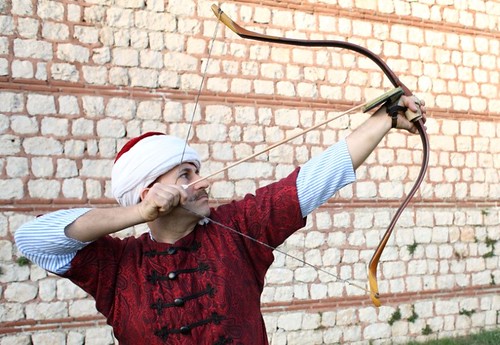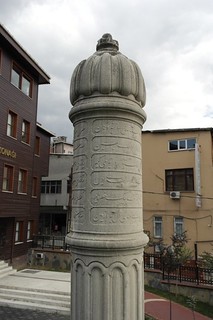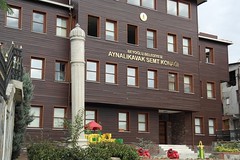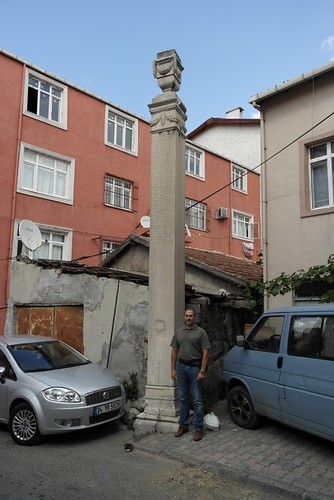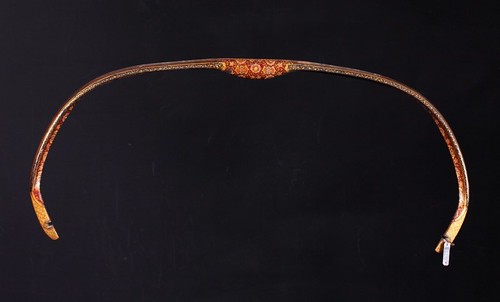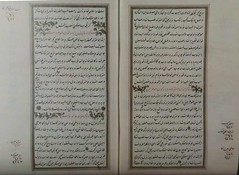 A Turkish Archer On The Tracks Of His AncestorsDr. Murat Özveri The request from my French archery friends about writing about Turkish archery and my role in reviving this unique culture has been an occasion for a pleasant contemplation and a precise retrospective evaluation of my past 17 years. All started with a decision of buying a recurve bow in 2002, a few months after I shot a few arrows in a holiday resort in Marmaris Turkey. I have been interested in archery since I was 14 years old, but I didn’t find the occasion to start archery until after I had got my PhD degree in Periodontology in late 2002. It was a long journey with a lot of traces and scars in my soul and archery somehow became a rehabilitative, re-creational activity at the very beginning but it didn’t take a long time that it turned into something more serious, something that settled in the centre of my life. I had to start shooting with Olympic-recurve since it was one of the two available disciplines in the country. Shortly after that, I discovered that we, modern Turks, were the inheritors of an exceptional archery culture but forgot it almost completely. The Turkish Republic was the continuation of the Ottoman Empire. The gradual collapse of the Empire had diminishing effects on the cultural and social life in the mid-19th century and the First World War became one of the milestones followed by the invasion of the country and the Independence War, and at the end, founding of the Republic. The Archer’s Lodge (Okçular tekkesi) in Istanbul, the Ottoman Capital, was destroyed by a severe earthquake in 1894 but as an institution and as a nest for the archers to come together at it had lost its importance before. There were Archery Fields (okmeydanı) as much as 36 in the Empire, from Cairo to Budapest, and on some of them there were lodges which hosted thousands of archers during more than 400 years. These institutions were not too much different from modern sports clubs. They had libraries, dormitories, refectories, other than a very well-developed system for training, competition, performance assessment and documentation. There were a few Archer’s Lodges in big cities of the time, like Cairo and of course Istanbul. The earliest Archery Fields were established in the early 14th century in Bursa and Edirne, the previous capital cities of the Empire before the Roman capital, Constantinopolis was captured by Sultan Mehmed II in 1453. However, there are records about distance shooting in Seljuk Empire that ruled a large land that is modern Iran, Iraq, Syria and Turkey. The cultural roots of distance/(flight) shooting can be traced back to pre-Islamic Turkish culture. But Turks found good explanations for their practice as well as rituals, and made justifications that match their current Islamic character. This kind of “Islamic dress” could be found on many aspects of the tradition and reveals a fine syncretism that exists almost everywhere, in any culture. Target shooting was also performed on Archery Fields. In fact, archery was mainly a martial art and the main rationale of shooting a bow has always been hunting and war. However, flight shooting had been popular among Turks even before the 16th century when firearms began being dominant on battlefields. Flight shooting gained more popularity after the introduction and spread of firearms but the existence of this “sport discipline” before the 16th century confirms the sporty character of Turkish Archery. Archers shooting at „puta basket”put at 165 m distance in Istanbul okmeydanı, as drawn by a miniature artist in 17th century. Ottoman archers reached incredible distances with the legendary Ottoman composite bow and these achievements were accurately recorded. In the documentation of these record shots some of which exceeded 800 metres, Islamic regulations were carefully followed. Each of these record shots had to be witnessed by at least two persons on the spot which the shot was executed on, and by at least two persons who saw the arrow lands. It’s known that some famous archers of their time gathered thousands of people for record attempts, very much similar to popular sportive activities of modern times, like football. Archer’s Lodge (Okçular Tekkesi) as painted by Swedish envoy Carl Gustaf Löwenhielm in 18th century. These undisputable and unsurpassed achievements also were confirmed by European witnesses. Only one foreigner, Lady Mary Wortley Montague, the wife of the British ambassador (1716-1718), who wrote a series of letters to her relatives and friends in Britain, was allowed to enter the Istanbul Archery Field by the approval and order of the sultan. This lady also witnessed Sultan Ahmed III’s archery performance and wrote about that in her memories. Another case that was recorded almost a hundred year later was in England. Ottoman Consulate’s Secretary (Sefâret Kâtibi) Mahmud Efendi shot together with the members of Toxophilite Society in London. He could easily overshot the English longbowmen in flight shooting. His longest shot was measured 440 m, which was 110 m further than the maximum distance that had been achieved by English longbowmen at that time. Mahmud Efendi said humbly that his bow was not conditioned (which was true since composite bows required a sort of “heat treatment” for better performance), but with this performance of him he would not be considered as a proficient archer in Istanbul. His sultan (Selim III) was a superior archer who would easily shoot much further. It was true and Sultan Selim had many records, some of which had been declared by erecting monumental columns in the memory of those particular shots. Flight Shooting was the most popular discipline in Turkish archery. Distances over 800 m were reached and very well documented (Photo: Suat Gürsoy). Erecting monumental columns (menzil taşı) for that purpose was a norm, it wasn’t for sultans only. The roots of this tradition can also be followed back to pagan/animist Turkish culture. Warriors had been honoured with primitive sculptures erected next to their graves. These “tombstones” were called “balbal” and each represented an enemy killed by the dead when he was alive. Sultan Selim’s “Menzil taşı” in Okmeydanı, the district that is named after the Archery Field of Ottoman capital city (Photos: Tunç Beyhan). These stone-monuments are called “menzil taşı” or “nışan taşı” and named a few districts in Istanbul because of some remained stones of that type in that area, as would be expected. The number of menzil taşları (flight stones) on the Istanbul Archery Field was almost 300 in the 17th century. Unfortunately, most of them became the victims of unplanned urbanisation; stolen, abolished or lost. There are only some below 40 some of which are not intact. They can be seen in situ in Okmeydanı, the district that was named after the Field, now full of buildings that had been illegally erected, covering later been legalized by politicians to show how badly the hunger of vote-seeking politicians gobble everything, including irreplaceable cultural values! Istanbul Okmeydanı was still a field in 1940s. The unstoppable migration in 1950s and 60s from countryside caused an uncontrolled urbanization which also brought the end of the field and of many of these stone monuments (Photo: Author’s archive). Stone monuments lost in between the buildings of unplanned and illegal urbanization. This menzil taşı was erected in the memory of a record shot by Sultan Mahmud II in mid-19th century (Photo: Tunç Beyhan). This monument has later been brought to the yard of newly re-built Archer’s Lodge but our suggestion about erecting a plastic replica of it to keep the in situ position, was simply ignored. Turkish archery is fascinating with its cultural aspects alone. The first systematic sport archery in the world inherited solid evidences other than these stone-monuments. There is the Lodge Registration Book (Tekke Sicil Defteri) that contains the names of archers who were able to prove their proficiency by shooting at 900 gez or (594 m) with a pishrev arrow or at 800 gez (524 m) with an azmayeesh arrow, these two main type arrows having been used in flight archery. It was the minimum requirement, and as said above, was very carefully and meticulously evaluated and documented. This minimum requirement made the archer “grip owner” (kabza sahibi), referring to an initiation ceremony in which a strung bow(-grip) was given to the archer by his master. This ceremony was called “Büyük Kabza Alma Töreni”, literally “Great Grip Taking Ceremony”, a ritual based on symbolically transferring the archery knowledge from the master to apprentice, from one generation to the next one. The grip of bow has a symbolic meaning as interpreted by sufis (Muslim mystics): it is the part of bow where the lower and upper limbs come together, fuse, become one for the sake of making a functional bow. While the lower limb symbolizes the “inferior”, “bad” and “evil” the upper limb symbolizes “superior”, “good” and “holy”. Each of these little curves has no meaning without the co-existence of the other, like all the dichotomy pairs in universe, and here they unify perfectly on the grip of bow. Unlike the orthodox Islam (and other monotheist religions that are based on a dualist approach to opposites) Islamic mysticism accepted and embraced a different imagination of Cosmos and Creator. Archery, as one of the sublime martial arts of medieval Muslim culture, has also been enriched by the heterodox approaches of the religion. Pishrev arrow has a chested shaft and a tiny tip made of bone called a „soya”. Their fletching is mace-shaped. Both of these features differentiate them from „azmeyesh” arrow that has a longer, low-profile fletching and a tiny, olive-shaped metal tip, called a „zeytûnî temren”. War and hunting arrows are relatively thicker and longer although they are still lighter and thinner compared to their western cousines. Ottoman arrow shafts have different diameters along their length which was a norm, however there were different patterns in flight, target and war arrows. An Ottoman bow with unique symbolization: The grip is the part of bow where dichotomy pairs of universe unify at. It refers to God who, from a mystic point of view, is “Indivisable Oneness”. In Islam this concept is called “tawheed” (Topkapı Palace Museum, Photo: Fuat Özveri). The Registration Book had two volumes but the first volume burned in a big fire in the 16th century. Kȃtip Abdullah Efendi who was the “Sheikh” of Istanbul Archer’s Lodge, started a new volume in 1683 and this remained with the names of all those sports heroes. Kȃtip Abdullah Efendi is an important character in the history of Turkish archery. In his time, Archer’s Lodge was under the management of bowyers and fletchers which was against the law. Sultan Mehmed II had given the Field to archers just after the conquest. The Field as well as the later built Tekke (Lodge) had been directed by them until political games ended up with the dominance of these two handcraft guilds in the management of the Lodge. Kȃtip Abdullah Efendi was a scholar of his time. He applied to the sultan and asked for his help to “rescue” the Lodge. Sultan Mehmed IV, also known as “Mehmed the Hunter” because of his obsession for hunting, wanted Abdullah Efendi to show his skills. According to the historical records, he demonstrated archery skills like target shooting, puta shooting, flight shooting and shooting from horseback. The sultan was convinced and ordered the handcraft guilds to leave the management to. Abdullah Efendi. He became one of the few Sheikhs of Tekke, who were assigned by the sultan. Others were elected from proficient (kabza sahibi) archers by the others. This aspect was also unique by any means. A solid evidence of democracy (or meritocracy could be a more accurate term) in a society with solid class discriminations and a country with strict monarchy! Abdullah Efendi left more solid heritage than the second volume of the Registration Book. He wrote several books about Ottoman archery. One of them, “Kavâidü’r-Remy” (Rules of Shooting), gives high quality information about the system, shooting techniques, bows, arrows, thumbrings etc. Fortunately, the written sources are not limited with those written by him. There are a vast number of manuscripts from Ottomans and Mamluks from which we can harvest information about Turkish archery. Mamluk warrior-elite wrote both in Kipchak dialect of Turkish and in Arabic while the Ottoman sources are all in Turkish. But it doesn’t mean that the modern-time researchers have an open highway to go. The cosmopolitan cultural character of the Ottoman Empire caused radical changes in the court language (which is called “Osmanlıca”), especially in 18th and 19th centuries. Another problem was changing the alphabet to Latin in 1928. The “Old script” was not forbidden but wasn’t taught in the schools after this reform. History and Turcology departments of universities kept teaching it, so historians and researchers are of course skilled in “deciphering” old texts that have been saved both in libraries and in the “Ottoman Archive of Prime Ministry”. In my story, I had to go to a course to learn the old alphabet to be able to “be more familiar” with archery treatises. In a short time, I started working on the subject systematically, gathering and coordinating interested people. Historians joined us, and later, with the increase in the popularity of traditional archery, more and more academics came on the scene. Some important (and some insignificant) archery treatises have been transcribed and published, and luckily, they are still being transcripted. Museum research is very important in the revival of traditional archery. Author examining chainmail and a Crimean Tatar bow in the Military Museum, Istanbul (Author’s archive). Turkish archery literature. Some of the newly published work in Latin alphabet include the original text’s facsimile. Some of the must-reads on Turkish archery and bowyery some of which are available in English. Some of those have even been translated to other European languages and published, like the one by Adam Karpowicz.. The revival movement started and is continuing, with both serious research and shallow political show-offs. More and more people are interested in Turkish traditional archery and there are more and more traditional archers. I have been working with a group of highly-motivated archers under the banner “Tirendâz” since 2008. We have been practising and teaching archery, writing, making amateur videos, giving lectures, examining museum samples, doing experimental studies, participating on TV programs, archery events and competitions. Turkish traditional archery became my way. I have been scudded by it, enjoying many aspects of this exceptional culture, that seems to be an unending, life-long journey. This article was published in Tirà l’arc Magazine (No: 46, 2019, 69-73) in France under the title “Archerie Ottomane, Un archer turc sur les traces de ses ancêtres” as translated by Cécile Lafaurie.  |



